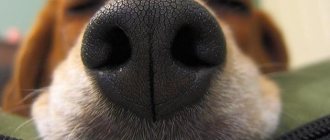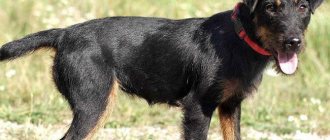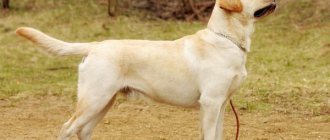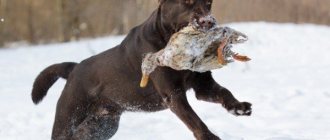A Labrador can be kept and lived in an apartment only under certain conditions. A large dog is a hunter and requires special care, education, and physical activity.
In a city apartment, you can provide high-quality care, the dog will feel good, and the owner and neighbors will not feel any discomfort from the animal’s presence.
Features of the breed and character of retrievers
The Labrador Retriever has an easy-going character, active and emotional. The blood of a hunter flows in his blood, he has natural passion, diligence and excellent mental abilities.
Caring for a Labrador is not complicated; it includes a whole group of constituent elements that are impossible without each other.
Care and maintenance includes its pros and cons and consists of:
- Hygienic measures;
- Proper diet;
- Physical activity;
- Education and training;
- Communication with animals;
- Vaccination and vaccination regimen;
- Arrangement of the place and apartment.
The breed is unique; it harmoniously combines the following service qualities:
- Excellent search engine;
- Possessor of a sensitive sense of smell;
- Guide-dog;
- Service officers at the border, airports and fire stations.
The only thing that is not ideal is its protective qualities; the Labrador is a friendly and sociable pet. Ideal for a single person, a large family with small children, living with other pets.
The pet is obedient, efficient, and trains well. Conflict and aggressiveness are completely absent. Loyal, loving and respects people. Sufficient physical activity, a balanced diet and a well-equipped place will help to maintain and maintain a quality life for the dog.
- A pet can become a nanny for a child, or a nurse for an elderly person. The peculiarity of his character and nature is that he is not a pet, but a real member of the family in which he has an important place. He loves everyone with his dick, regardless of who walks or feeds, but the owner is a person who is involved in education and has authority for man and dog.
He cannot be alone for a long time, he is prone to pranks, a huge plus is that he rarely barks or howls. If there is a lack of attention and physical activity, he will help you make repairs, will begin to tear wallpaper, gnaw on door frames and furniture, belongs to an early age; adults rarely express themselves in this way.
General characteristics of the breed
The Labrador dog belongs to the gundog group and has the following features:
- has a stable psyche and balanced character;
- has a good temperament with a complete absence of aggression;
- can perform various official tasks;
- has webbed feet, so it moves quickly and easily in the water;
- has a strong physique and jumps well;
- is distinguished by a soft grip of the mouth (does not press down the load);
- The tail, wide at the base, serves as a rudder when swimming;
- the coat is multi-layered and adapted for swimming;
- representatives of the breed are distinguished by obedience and a desire to interact with humans;
- Has generally good health, but problems with the joints and eyes are possible.
Labrador dogs are distinguished by their love of both play and work. They are called sprinters for their ability to move very quickly and swim at high speeds.
Owners need to take into account that this breed needs constant exercise - the dog will happily accept any game. The dog is friendly and sociable, affectionate and intelligent. For this reason, he cannot be a security guard - he even greets strangers.
Reviews from many owners indicate that this breed is perfect even for beginners who have never owned dogs in the house. In addition, animals are wonderful nannies and cheerful friends for children.
Given their positive qualities, Labradors are used as:
- companions for elderly and disabled people;
- guides for the blind.
These dogs make wonderful rescuers and detectors of illegal substances.
Life expectancy is about fifteen years.
Keeping a Labrador Retriever - necessary conditions
Keeping a Labrador does not require outdoor conditions; it cannot live in an enclosure or on a chain. Accommodation is only possible in an apartment, private house or country residence. Not suitable for life with restricted movement and living in street conditions.
It cannot be without a person or live separately from its owner.
For a comfortable stay together, from the first days of the puppy’s arrival, it is necessary to create appropriate conditions. This is not difficult, follow the recommendations and the result will meet your expectations.
Before your baby arrives, prepare:
- A warm and soft bed where he will sleep;
- Choose a place to eat, preferably the kitchen;
- Buy toys with squeakers and regular “no sound” toys, balls of different sizes;
- Food bowls;
- Bowl stand or wall mount;
- Feed;
- Combing brushes and slicker brush;
- Shampoo, lotion for animal care (ears, eyes);
- Nail clipper for cutting nails;
- Treats and dental bones;
- Disposable diapers;
- Collar and leash, harness;
- Parasite repellents: fleas, ticks and anthelmintics;
- Cover and cover for a sofa, bed, car.
Features of the first days of life
The puppy must get used to the new place; it will require time and initial socialization. The owner needs to prepare the house and household for proper behavior.
What you need from the owner:
- Remove all small objects that the puppy can reach and eat;
- Breakable items, glass, small parts or objects;
- Wires and extension cords;
- Shoes and things;
- Lift everything that the puppy can reach to the top;
- Carpets and carpet are removed or covered for the first time;
- Cover the place where the baby eats with oilcloth - on the floor and wall;
- Remove cat litter boxes (he will dig around there and may eat poop or litter);
- Place powders, cleaning products and other chemicals out of reach.
Imagine that you have a small child who does not walk and puts everything in his mouth, all the steps in preparing the apartment are similar.
Before you start caring for your Labrador, make sure that you have all of the above, be mentally prepared for puddles on the floor, piles in the corner and pranks.
Paw shape
Dog handlers distinguish three types of dog paws:
- feline;
- hare;
- membranous.
The cat's paws are compact and round in shape. This type of structure is typical for large breeds of dogs, which are characterized by high endurance. Dogs with this paw shape require less energy to move. Breeds with cat paws include Dobermanns, Giant Schnauzers and some Shepherds.
Hare's feet are common in racing breeds, such as hounds or greyhounds. The structure of the paw is elongated, with long middle and ring fingers. It is convenient to develop high speed with such paws, but maneuverability suffers.
Webbed feet are found in hunting breeds and rescue dogs. So you will find membranes in varying degrees of development in Labradors and Newfoundlands. But you shouldn’t think that the membrane is visible, like a goose’s; no, on the contrary, to see the fold you need to straighten the dog’s fingers.
Primary puppy socialization
Once a little Labrador arrives in a new apartment, it will take time to get used to the environment. Gradually accustom him to a place to sleep and a place to eat. When sending to the place, give the appropriate command.
Demarcate the territory; a bed and a place for eating are different places. Disposable diapers are placed much further from the sleeping area.
You will need to train your puppy to:
- New nickname, call him by name as often as possible;
- Wearing a collar and walking on a leash (start with a short time, put on the collar and leash before
- every time you go outside, at home, all the equipment is removed);
- At first, carry it in your arms; the puppy should not go down the stairs on his own;
- Go outside at least 3-4 times, preferably immediately after sleeping and feeding;
- Accustom to new sounds: TV, car noise, crowded places;
- Loud sounds: thunder, rain, thunderstorm, fireworks, screaming children, music;
- Visit crowded places as often as possible;
- Change routes;
- Take it with you to the store.
After 2 weeks or 5-7 days, start your first lessons on learning commands. The simplest ones are taken, on their basis all training in the future will be built:
- It is forbidden;
- Sit;
- Place;
- Wait;
- Ugh;
- Lie;
- Voice.
If you are planning to take your Labrador hunting, read our article about the peculiarities of upbringing in advance. As soon as you have learned the first commands, move on to more complex ones, increasing the time of training; more about the nuances of training below.
Education and training
After initial socialization and training of commands, move on to more complex ones. OKD classes, sports competitions, Frisbee. Reinforcement includes treats and verbal praise.
During training:
- It is prohibited to punish;
- Screaming and being rude;
- Use physical force;
A reward system is used: treats - food pellets, cheese, sliced chicken breast, pieces of fruit. Classes begin after walks, to avoid distractions. You will have to apply persistence; you cannot stop the lesson if the command is not completed.
The owner can show with his hands what is required from the pet: sit by pressing on the sacrum.
Training takes place with alternating active games, it is necessary to ensure that the dog does not stand. The training is carried out by one person; by the age of 6 - 7 months, the Labrador must know the basic commands and carry them out accurately, unquestioningly.
How to accustom to a home environment
Keeping a Labrador puppy in an apartment will not bring any particular difficulties. Children quickly get used to new things; it is enough to accustom them to a diaper and quickly take them outside, after sleep, to the toilet.
- Puppies are initially clean; it is worth giving a little guidance and setting boundaries. You can punish only immediately after the offense, if you did not see how the puddle appeared in the wrong place, you can no longer scold.
The puppy will not understand how and when he did something wrong, prepare yourself mentally for all the difficulties, take them for granted. In 2 - 4 weeks he will get used to it, and when he finally matures, there will be no problems. The main thing is to beckon about the need for early education and control over actions from an early age.
Should it be kept in a cage?
Labrador retrievers and dogs in general perceive the crate as their place where they feel comfortable. They feel protected in the cage, without perceiving it as punishment. Instead of a bed or nest, you can put a cage where there will be a warm bed for the puppy.
During your absence, the cage is closed, the animal is released immediately after the owner comes home. He can't spend all his time in a cage. It is better to keep babies in a playpen, and after 3 months transfer them to a cage.
For punishment or restriction - the cage is not used, only during your absence; the time when the dog is closed should not exceed 4 hours.
Interesting things about Labradors
A lot of interesting things can be said about this breed.
Here is some information about Labradors:
- This is the only dog breed that has webbed paws;
- within three seconds they can reach speeds of up to twenty kilometers per hour;
- the speed of a dog in water is twice as fast as a duck’s swimming speed and reaches five kilometers per hour;
- The Labrador's sense of smell exceeds that of the German Shepherd by twenty-five percent;
- animals have excellent memory and intelligence (they are able to remember not only their names) - Labrador dogs can understand up to two hundred and fifty gestures and words, reproduce up to forty-five routes (German Shepherd - half as much);
- Labrador can dive to a depth of fourteen meters and swim under water twenty-five;
- A dog's jump is eight meters long.
According to owners' reviews, Labrador is the best breed to choose if you need an assistant, companion and cheerful friend for adults and children.
Caring for a puppy and an adult
In order to know how to care for a Labrador puppy and an adult, it is important to understand that care is not limited only to hygiene or feeding, complete care has multiple components. To maintain your dog, do the following regularly:
Bathing
Wash your Labrador only when necessary and when dirty. It is forbidden to use human shampoos, only dog products. The water should not be cold or hot.
After swimming in open water, rinse with running water and dry. In winter, refrain from water procedures. Avoid blow-drying; simply wipe with a dry towel.
Washing paws after walks is mandatory. In the summer, removing dust and dirt from the fur with a damp cloth after each walk, there is no need to bathe it completely.
Wool
Brush your pet weekly, the brush should not be hard, the length of the teeth should be medium. During the molting period, scratch every day, thoroughly, for 20-30 minutes, paying special attention to: the stomach, groin area.
During the molting period, the fur and undercoat are removed with a slicker brush, the dog is washed more often, which promotes skin renewal.
Eyes and ears
The eyes are wiped 2-3 times a week with a decoction of herbs with an antiseptic effect (chamomile) or a weak solution of tea leaves, a specialized care lotion.
Clean your ears as they become dirty or at least 2 times a month. A cotton pad or swab soaked in lotion or dry. There is no need to press hard in the ear. Monitor the nature of the discharge: is there any redness or a strong odor.
Teeth
They can be cleaned independently using a brush. Or dental veterinary remedies are given in the form of “bones”, which help cleanse, remove plaque from the teeth and improve digestion.
Give solid food to chew: large moles, raw carrots, apples.
Claws
With sufficient physical activity and constant running, they wear off on their own. You can remove it yourself using a nail clipper. It is important to do the procedure carefully, trying not to injure the body of the claw. Teach from an early age, after each haircut - give a treat and praise.
Vaccination regimen and treatment against parasites
The first vaccinations are given by the breeder; you just need to follow the schedule and get vaccinated on time. Puppies have their own schedule, adults are vaccinated according to a different schedule.
Visit the veterinarian for a simple check-up once every six months. Mandatory consultations before changing food or mating, choosing food additives and vitamin complexes, only with the recommendation of a veterinarian. pharmacy or veterinarian.
Treatment for parasites, strictly according to the season. Before the start of the spring-summer period, processing the wool and wearing a collar. Check your fur and skin regularly for ticks, especially after traveling outside the city.
An anthelmintic is given to the puppy 7-14 days before vaccination, and then every 3-4 months. Adults once every 6 months.
Exercise stress
Walk at least 2 times a day - for an adult; take a puppy out 3-4 times for short periods of time.
Provide exercise for adults - free running, joint jogging with the owner. Free games with a ball, frisbee, games with other animals.
The duration of the baby's walks is gradually increased; it is important to ensure that he does not pick up food from the ground or dig through the trash. Let go of the leash and slag only when you know the basics of the command or you are sure that there is no danger nearby.
You can take a Labrador on mini trips, ride a bike or ski together. Walks together should be long, fun and productive for both pet and person.
Advantages and disadvantages of Labradors
Those who are encountering this breed for the first time should definitely know its pros and cons.
The advantages include the following:
- the breed was bred for work and to this day remains in excellent physical shape;
- These are strong and hardy dogs in good health - they tolerate icy water, frost and cold well;
- easily adapt to living in hot climates;
- do not require labor-intensive care;
- quickly learn commands, are easy to train, effective in agility;
- have an exceptional memory - they remember various places for a long time;
- do not spoil objects carried in the mouth, thanks to the soft grip;
- They are very devoted to the family and recognize the primacy of man.
A list of qualities of the Labrador dog breed that need to be treated with due attention:
- friendly with everyone, even with strangers - completely lacking guard qualities;
- require constant physical activity and activity;
- if the dog is bored, property damage is inevitable;
- The breed is characterized by slow maturation - until the age of three, puppyish behavior and occasional disobedience appear;
- the pet is ready to swim even in a dirty puddle;
- Labrador is not moderate in food - he tries to eat everything he comes across, even in a landfill on the street;
- loves to play with his relatives - on the street he is active with all dogs, regardless of size.
If you show interest in your dog and train it, most problems can be avoided.
Nutrition for an adult Labrador and a puppy
There are two types of food for dogs: natural feeding and commercial feeding. The owner decides which one to choose; upon arrival at the house, the puppies eat the food they were kept on by the breeder. Transition to a new type of food
Caring for a small Labrador puppy involves feeding 5 – 6 times a day with a time interval of 4 hours. Portions are small, intended for 1 serving. Transfer to 3-4 meals a day from 5-6 months, after six months 4 times, from the age of 12 months 2 meals a day. Adults eat 2 times a day after a walk, provide access to fresh, drinking water.
Dry food
Selected based on physical activity, age and characteristics of the Labrador. The feed is already fully balanced and does not require additional supplements in the form of vitamins and minerals. For puppies up to 4 months, soak in warm water until completely swollen and homogeneous.
- Preference is given to premium and super-premium food. Easy to store, no preparation required, fully balanced and meets all necessary requirements.
A bag of 3 - 5 kg is enough for 2 - 3 months. Labradors are prone to weight gain; improperly selected food can cause digestive problems.
Natural nutrition
For natural nutrition use the following products:
- Meat of low fat content, without bones and veins (veal, beef, turkey and chicken);
- Dairy products (cottage cheese, kefir and cheese);
- Eggs;
- Porridge (buckwheat, rice, wheat, oatmeal);
- Vegetables: zucchini, pumpkin, carrots, tomatoes, cucumbers, cabbage;
- Greens and lettuce;
- By-products: brain, stomach, lung, liver, heart;
- Sea fish;
- Fruits: apples, apricots, peaches, pear and banana;
- Bone flour;
- Vegetable fats;
- Additionally: large cartilages - gnaw;
Exclude from the diet:
- Bones, fish, chicken, any tubular;
- Grapes, plum;
- Pasta, bread;
- Spices;
- Potato;
- Citrus;
- River fish;
- Fat meat;
- Chocolate and sweets;
- Legumes.










